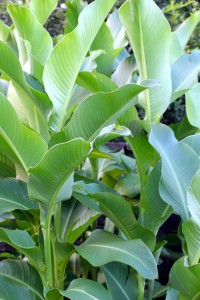
 A few people have asked me recently about this amazing plant and food source, and why it’s one of those essential permaculture plants to grow. It grows in wet feet, dry soil, handle summer heat and winter cold with ease, yields amazing mulch leaves and a great source of food (carbs). It’s excellent habitat for a range of creatures, provides great screening, privacy and shade for certain areas, grows well with any other plants and trees, and is so easy to grow pretty much anywhere. Please read more below.
A few people have asked me recently about this amazing plant and food source, and why it’s one of those essential permaculture plants to grow. It grows in wet feet, dry soil, handle summer heat and winter cold with ease, yields amazing mulch leaves and a great source of food (carbs). It’s excellent habitat for a range of creatures, provides great screening, privacy and shade for certain areas, grows well with any other plants and trees, and is so easy to grow pretty much anywhere. Please read more below.
Plant Names
Common Name: Queensland Arrowroot
Botanical Family: cannaceae
Genus: Canna (About the Name: canna means reed, and edulis ‘edible’ in Latin; indica connects the plant with India)
Species: edulis
AKA: Araruta, Bermuda Arrowroot, Chokwo, Maranta starch
Origins
South America and the West Indies. It has been domesticated in the Andean region, and is now a popular root crop right through South America. It is a market vegetable in Peru and Argentina where it is known as Achira. It even manages to survive at freezing temperatures and resists snow. These cannas are good multipurpose permaculture plants. The name derives from the indigenous South American Indian word araruta, meaning flour-root. Some accounts say it was once used to treat poison arrow wounds, while some tubers in this family are actually poisonous. It has been cultivated in Jamaica since the 17th century, where most of the world’s arrowroot supply still comes from.
Plant Description
This edible plant is closely related to the ornamental Cannas, except that it develops large tuberous rhizomes and has small orange flowers. It has been domesticated in the Andean region, and is now a popular root crop right through South America. It is a market vegetable in Peru and Argentina where it is known as Achira. It even manages to survive at freezing temperatures and resists snow. These cannas are good multipurpose permaculture plants.
History, Propagation and Cultivation
About 100 years ago, this formed the basis of an industry in Queensland. It was grown for its thick rhizome, which yields about 80 per cent starch. It’s really digestible for convalescents and for children. Old congested clumps benefit from being lifted and divided periodically and this is the best way to propagate them. Take a nice fat part of rhizome and an eye – that’s the bud – and plant them in spring. It takes about six months to produce a crop. But propagate them any time during spring or summer.
Arrowroot is frost sensitive and enjoys a fertile soil, a warm climate, plenty of moisture and lots of sunshine. A rust fungus, a species of Puccinia, causes leaf spotting on arrowroot. It is seriously debilitating. To avoid this problem, never recycle the leaves, roots or shoots around the plants as mulch, but it’s fine to use arrowroot in the compost heap. The other problem in Brisbane is with grasshoppers, but the best way to get rid of these is clap your hands – they go out with the sound of applause.
Arrowroot is a multipurpose plant. It can be used to create shade and shelter around garden beds, and this keeps things cool and it means the plants use less water. It’s brilliant for making compost and mulch. The tips of the shoots and the leaves are 10 per cent protein, which makes them great feed for pigs, goats and chickens. The individual leaves can be used as plates when you’re having a picnic. And use it to create screens from the neighbours.
Nutrition and Eating Arrowroot
Major Nutrients per 5 gram serve:
Energy 75kJ
Total sugars 0
Fat 0
Protein 0
Dietary fibre 0
Sodium 0
Carbohydrate 5g
Potassium less than 1mg
Arrowroot is mostly composed of carbohydrates. Other nutrients are in insignificant amounts. It has a slightly bland, nutty flavour, like a starchy flour. But the best part is eating arrowroot. To avoid the rather dry, flowery taste, slice them up and soak in water for four hours to remove the starch. They taste a little like water chestnut. Slowly roast them so they are soft and sweet, rather like parsnips.
 The most common use for arrowroot
The most common use for arrowroot
As a flour or powder, arrowroot is mostly used to thicken sauces, stews and soups, etc, but will lose its thickened effect if cooked too long. Approximately 1 teaspoon of arrowroot powder to 1 cup of liquid is used as a thickening agent. Arrowroot powder has a much greater thickening effect than corn, wheat and other flours and starches. The flour is also used to make arrowroot biscuits, which are famous in Australia (but these days contain little or no actual arrowroot powder anymore).
Recommended Recipe
Step 1: Clean and peel the arrowroot tubers, then soak the tubers in cold water overnight.
Step 2: Slice the arrowroot tubers to desired thickness.
Step 3: Add olive oil to a heated frying pan and lightly sauté the slices for approx 4-5 minutes, allowing some crunch. Add chopped garlic, sea salt, rosemary (or desired herb) and squeeze of lemon. (Other things can be added, such as seafood, meat or beans, etc)
Step 4: Toss and serve – on or with salad, on toast, as a cold salad, or any dish that requires a potato or tuber substitute.
Sources
– What Food Is That? (And How Healthy Is It?) by Jo Rogers
– Gardening Australia www.gardeningaustralia.com.au / www.abc.net.au/gardening
– Seed Savers http://www.seedsavers.net/handbook/queensland-arrowroot
